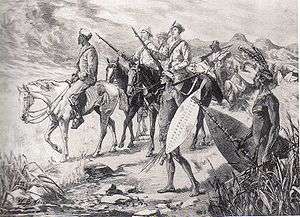Zibhebhu kaMaphitha

Zibhebhu kaMaphitha (1841–1904) (also called Usibepu/Ziphewu) was a Zulu chief. After the defeat of the Zulu Kingdom by the British, he attempted to create his own independent kingdom. From 1883 to 1884, he fought the Zulu king Cetshwayo, inflicting a series of defeats on him.
Life
Zibhebhu was a son of Maphita, son of Sojiyisa, son of Mhlabawadabuka (Lubimbi), son of Gasa (Ndindana). He was one of the 13 'kinglets' allocated land in the aftermath of the Anglo-Zulu War, and vied for the royal succession with another of Cetshwayo's sons, Dinuzulu. The British, seeing the futility of the division of Zululand, determined to restore Cetshwayo as the ultimate chief. However, they left Zibhebhu alone and his lands intact.
Both Zibhebhu and Dinuzulu befriended Boer mercenaries to help them in their claims. On the 22 July 1883, led by a troop of mounted white mercenaries, Zibhebhu made a sudden descent upon Cetshwayo's kraal at Ulundi, which he destroyed. All Zibhebhu's men wore a piece of leopard skin round their heads as a distinguishing mark. Cetshwayo escaped, though wounded, into Nkandla forest. After repeated pleas from the Resident Commissioner, Sir Melmoth Osborn, the king moved to Eshowe, where he died a few months later, possibly by poisoning.
Dinuzulu was left to fight for the succession, and with the help of General Louis Botha and Dinuzulu's Volunteers defeated Zibhebhu and his army at the Battle of Ghost Mountain (also known as the Battle of Tshaneni).
Skulls were so numerous at the site of the battle that they were used as road edge markers years later.
Zibhebhu and Eckersley, a white trader, escaped by climbing the Lubombo mountain. In September 1884 Zibhebhu guided the remnant of the Mandlakazi, about 6,000 people, into the Reserve; an area set aside for Zulu not loyal to the Zulu royal house.[1]
References
- ↑ The Destruction of the Zulu Kingdom
Jeff Guy
University Of Natal Press; 1994